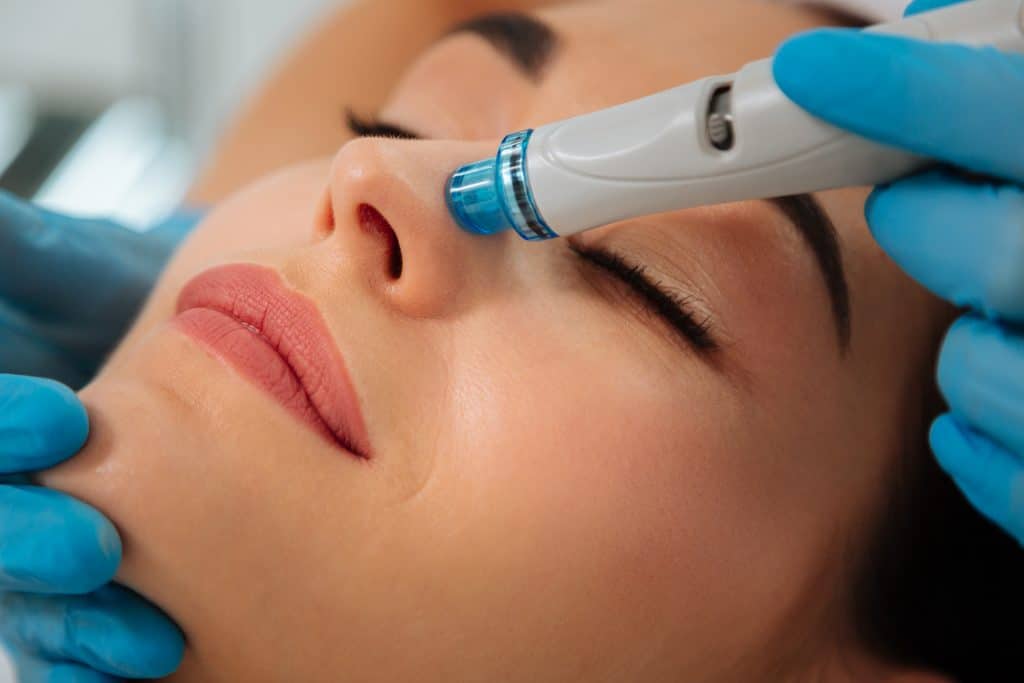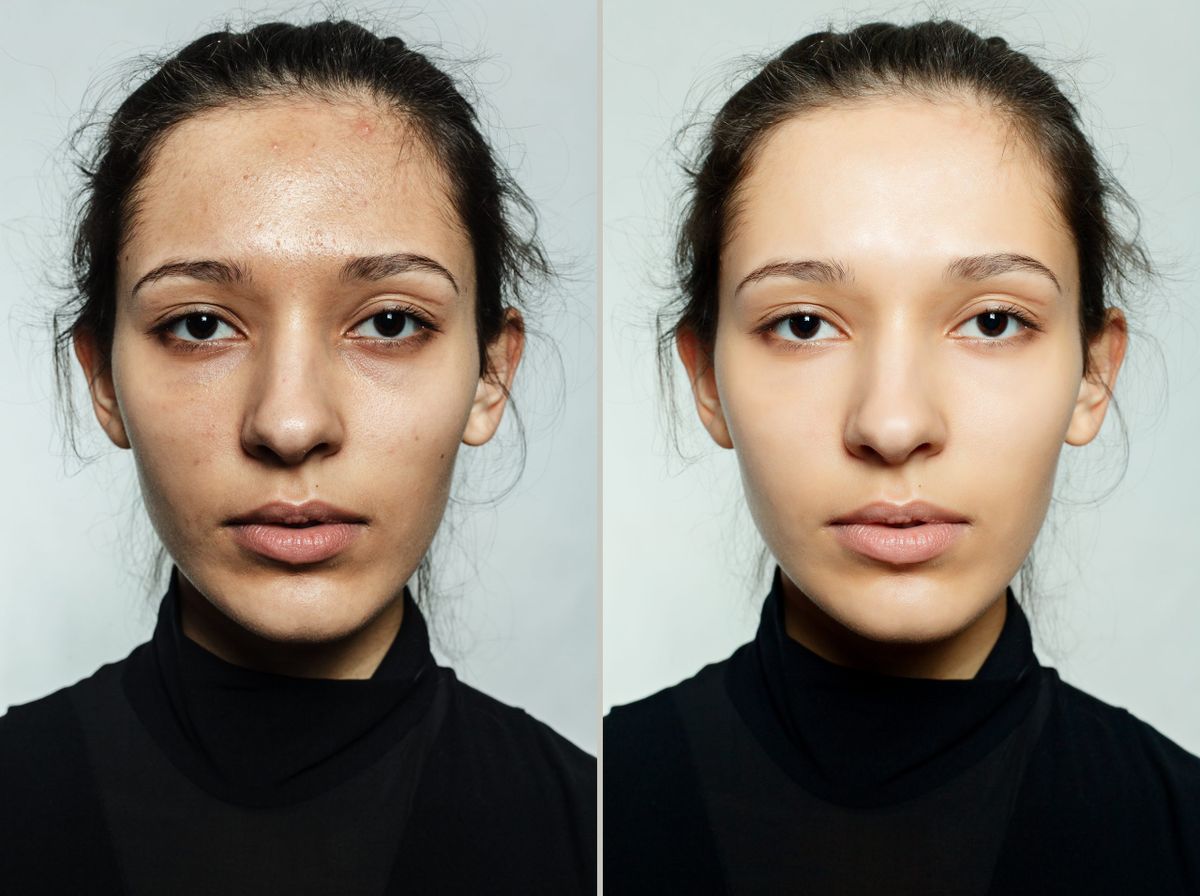What is microdermabrasion?
Microdermabrasion is a cosmetic treatment that uses fine crystals and a vacuum to remove dead skin cells from the surface of the skin. It’s considered to be a light exfoliation treatment as it only removes cells from the surface, especially when compared with deeper, chemical exfoliation procedures.
It isn’t an invasive procedure and is considered safe for most types of skin – you won’t need an anesthetic or any time of numbing agent for microdermabrasion. The treatment can be used on the face, neck, chest, back and hands. Facial microdermabrasion is the most popular area for people to have treated.
The treatment has been available in the US since 1996 and is approved by the US Food & Drink Administration. It’s also usually carried out by a skincare professional at their offices.
Why do people book a microdermabrasion treatment?
It’s used for a variety of reasons, but mainly to improve the appearance of the skin. The benefits of microdermabrasion include:

- Reduction of fine lines and wrinkles
- Lightening of age spots, melasma and sun damage
- Give skin a more youthful appearance
- Smooth skin and reduce scarring
- Tackle enlarged pores and blackheads
- Stimulate collagen production
By removing the top layer of skin, the body replaces the lost skin cells with new, healthy ones. This procedure stimulates blood flow, which can subsequently improve cell production, skin elasticity and texture.
We’d recommend discussing any specific skin concerns with a skin care professional to decide whether or not it’s the right procedure for you.
How does microdermabrasion work?
There are different types of microdermabrasion, but overall the outcome and process is fairly similar. It uses a tool with an abrasive surface to buff away the outer layer of the skin, leaving it feeling rejuvenated and improving its appearance. The treatment takes around an hour from start to finish.
An alternative method of microdermabrasion is a tool that sprays finely ground aluminium or sodium bicarbonate with a vacuum (or some other form of suction) to remove any debris. This is known as crystal microdermabrasion
There are even techniques like hydradermabrasion that push products into the skin, as well as the exfoliation part of the treatment. This treatment also stimulates collagen production in the skin.
You shouldn’t experience any pain, significant discomfort or burning with microdermabrasion, either during the treatment or afterwards. This is the case whichever method is used to carry out your dermabrasion treatment.
You’ll usually see results immediately after a treatment, and the number of treatments you’ll need (usually more than one) depends on your individual skincare needs. Usually the person who carries out your treatment will make a plan for you ahead of time, so you should know from the outset how many treatments to expect to have.
Side effects of microdermabrasion
Tenderness, swelling and redness can all be side effects of microdermabrasion – these side effects usually appear immediately after treatment and generally calm down within a few hours of treatment. There’s no downtime needed after a microdermabrasion treatment.
Dry or flaky skin could be a side effect that can be managed with a moisturizer. You also need to make sure that you protect your skin from the sun’s UV rays as it can increase sensitivity. There is also a slight risk of minor bruising from the suction tools used during the treatment.
Do your research ahead of booking your microdermabrasion treatment to ensure that you’re in safe, experienced hands. In the grand scheme of things, microdermabrasion is a fairly low-risk treatment but it is best to ensure that the right person will be carrying it out through research and recommendations.
If microdermabrasion is done incorrectly, or overdone, then you can cause damage and irritation to the skin. This can lead to further sensitivity and inflammation, which in turn can mean broken veins and pigmentation. Long-term damage is rare but it can happen, which is why we recommend going to someone experienced, reputable and capable.
Microdermabrasion isn’t recommended if you have skin conditions such as rosacea, eczema, active sunburn, herpes, lupus, open sores, psoriasis, fragile capillaries or very serious acne. These conditions can all be exacerbated by microdermabrasion so in these circumstances, it’s best avoided.
What to expect at a microdermabrasion treatment
You’ll either be seated in a reclining chair or laid down on a bed for your treatment. A handheld device will be used to spray the areas you want treated. This will slough away the outer layer of dead skin, which is then sucked away from your skin. It might be a little noisy, but no worse than any other treatment that uses a device.
Before your microdermabrasion treatment, it’s likely that you’ll be advised to do the following:
- Avoid sun exposure for a week before treatment
- Do not use tanning creams for a week before treatment
- Avoid waxing for a week before treatment
- Avoid exfoliating creams or masks around 3 days before your treatment
- Remove makeup and cleanse your face properly before your procedure begins
The aftercare advice following a microdermabrasion treatment is usually as follows:
- Keep your skin hydrated
- Use gentle products on your skin
- Avoid using topical acne medications for at least 24 hours after treatment
- Use sunscreen to protect your skin for weeks after treatment
You can expect to see noticeable results immediately after the procedure. The number of microdermabrasion sessions needed will depend on the severity of your skin concerns as well as your expectations.
How much does microdermabrasion cost?
According to the American Society of Plastic Surgeons, the average cost of microdermabrasion is $136. This will depend on your geographical location, provider, the areas of the body being treated and the number of treatments you have. As it’s a cosmetic procedure, it’s unlikely to be covered by medical insurance so you will usually need to self-fund.
What about at-home microdermabrasion?
The treatments you have from a professional will always be stronger than those carried out at home but will usually be cheaper.. Use a reputable brand and use cautiously at first until you know your skin is comfortable with the product. A microdermabrasion cloth is an easier, popular alternative.





